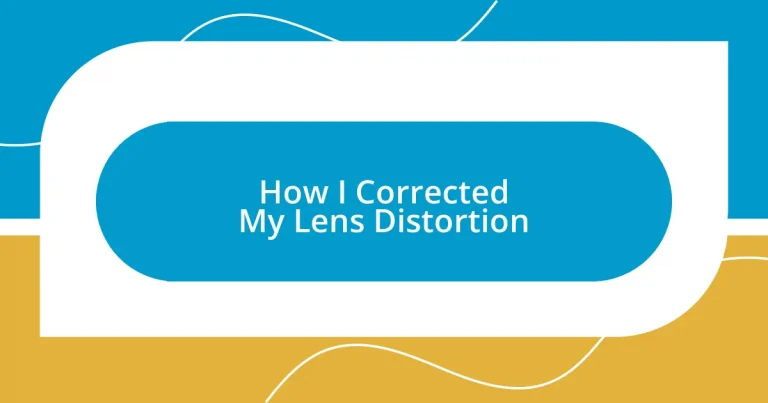Key takeaways:
- Lens distortion primarily manifests as barrel, pincushion, or mustache distortion, each significantly affecting image quality and composition.
- Effective distortion correction can be achieved through software (e.g., Lightroom, Capture One) and manual techniques like cropping and perspective adjustments.
- Preventing lens distortion involves careful lens selection, optimal camera positioning, and using appropriate aperture settings to enhance overall image quality.
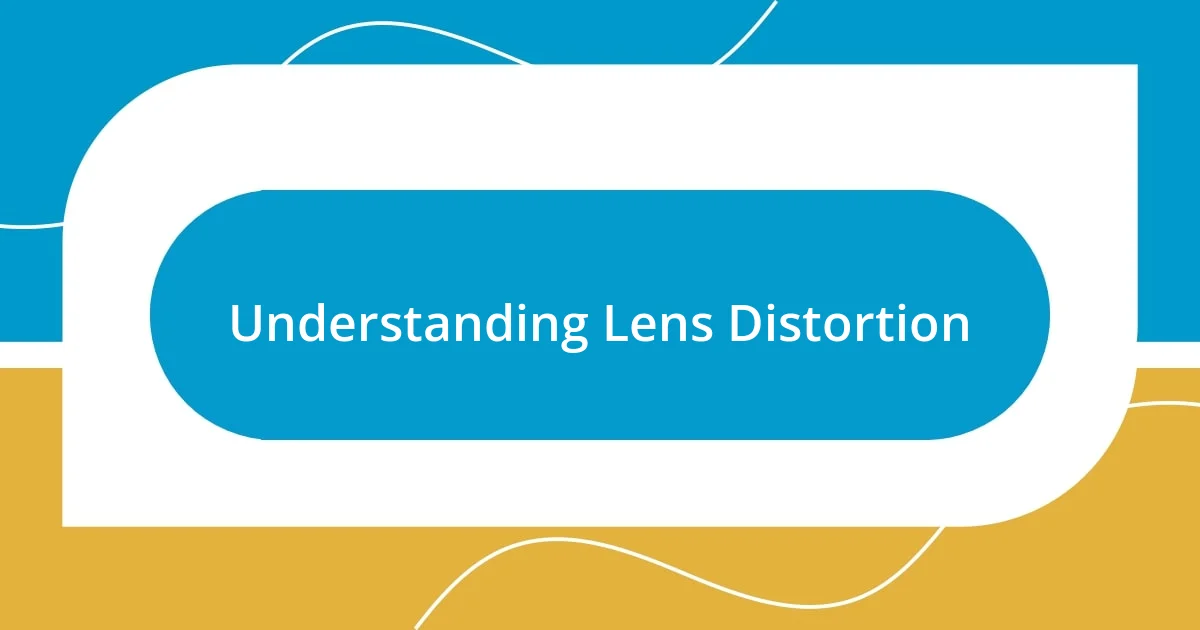
Understanding Lens Distortion
Lens distortion can often feel like an uninvited guest at a photo shoot, subtly altering the world as your lens sees it. I remember the first time I saw barrel distortion in an image; the horizon seemed to curve outwards, creating an almost surreal effect. I wondered, “Is this what I wanted to capture?” This realization sparked a deeper understanding of how different lenses interact with the subjects in front of them.
As I delved further into this topic, I discovered that there are two main types of distortion: barrel and pincushion. Barrel distortion makes images bulge outwards, while pincushion does the opposite, pinching the center. It’s fascinating to think about how even slight variations in lens design can lead to such significant effects in our photos.
I’ve found that appreciating lens distortion can add authenticity to your images, but it can also challenge your vision as a photographer. There’s this moment of frustration when you realize that stunning landscapes might turn into oddly shaped shadows due to a lens flaw. But isn’t that the beauty of the craft? Each twist and turn of lens distortion teaches us something new about the relationship between our gear and the world around us.
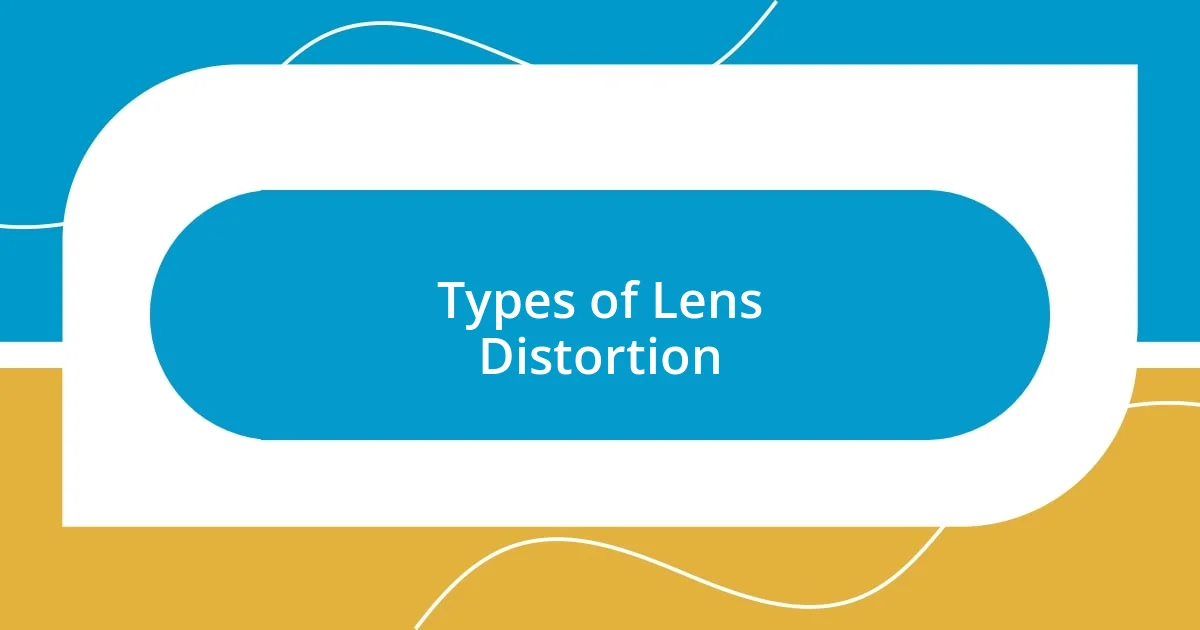
Types of Lens Distortion
When it comes to lens distortion, I always keep an eye out for two primary types: barrel distortion and pincushion distortion. Barrel distortion has this surreal way of making straight lines curve outward, which can create an exaggerated, dreamlike scene. I remember capturing a stunning sunset over a lake, only to notice how the reflection of the trees seemed to bulge around the edges, adding an unexpected artistic flair. In contrast, pincushion distortion draws lines inward, pinching the image at the center, giving it a unique twist that can feel both disorienting and intriguing.
Here’s a quick breakdown of the types of lens distortion I’ve encountered:
- Barrel Distortion: The image appears to bulge outward, affecting straight lines at the edges.
- Pincushion Distortion: The image seems to pinch inward, distorting straight lines by curving them towards the center.
- Mustache Distortion: A combination of barrel and pincushion distortion, creating a wavy effect that resembles a mustache shape, often seen in wide-angle lenses.
Understanding these distinctions helps me decide what lens to use for each shot, always keeping in mind how distortion can either enhance or detract from my artistic vision.
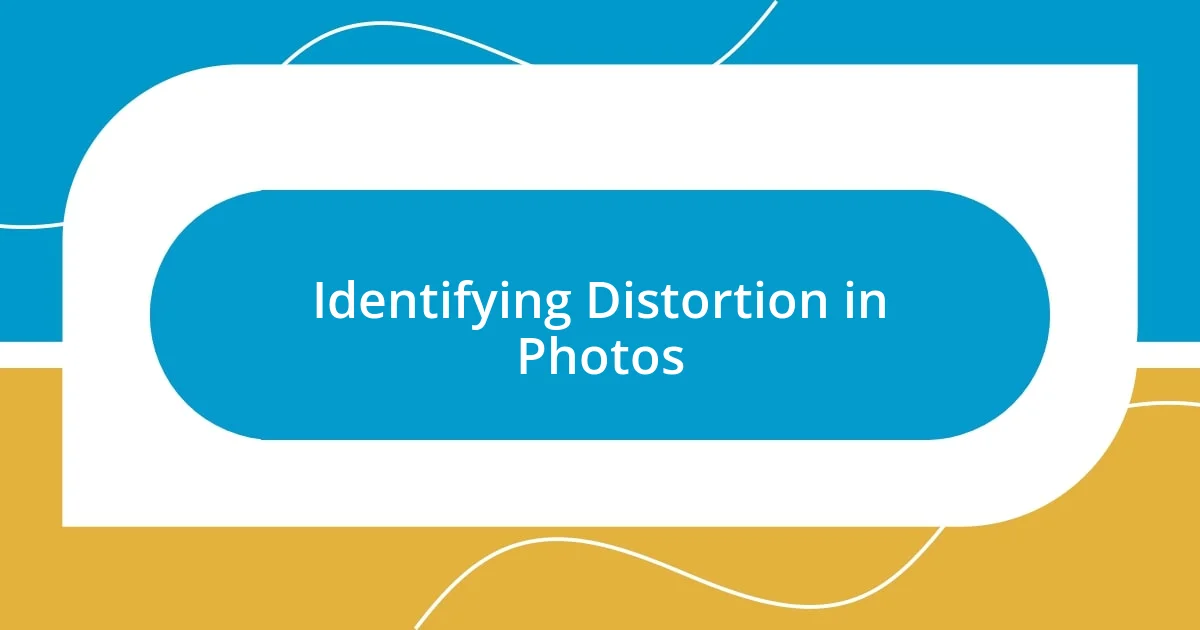
Identifying Distortion in Photos
Identifying distortion in photos can be a bit tricky at first, but once you know what to look for, it becomes almost instinctual. I recall a time when I was reviewing a series of urban shots, and I glimpsed a familiar warping around the building edges. It hit me—this wasn’t just my imagination! The lines weren’t as straight as they ought to be, hinting at lens distortion. I learned to keep my eyes peeled for these signs, especially when photographing architecture.
One of the most effective ways to identify distortion is by examining straight lines in your composition. If you notice them bending or curving in unusual ways, you’re likely facing either barrel or pincushion distortion. I once captured a long stretch of railway, only to see the track lines gracefully bow outward at the edges. It was a beautiful image but certainly not what I intended. Exploring how these distortions affect your subject makes it easier to spot them in future shots.
I often find it helpful to compare the corner versus the center of the image. If there’s a significant difference in line straightness, chances are you’ve encountered lens distortion. This reminds me of a picturesque landscape I shot last summer. The vibrant colors at the center drew me in, but as I examined the edges, I noticed the once-straight tree line subtly bending towards the frame’s corners. Identifying these details has genuinely enriched my photography journey, helping me better understand the tools I work with.
| Type of Distortion | Characteristics |
|---|---|
| Barrel Distortion | Lines bulge outward, curving edges |
| Pincushion Distortion | Lines pinch inward, distorting the center |
| Mustache Distortion | Combination of barrel and pincushion, wavy effect |
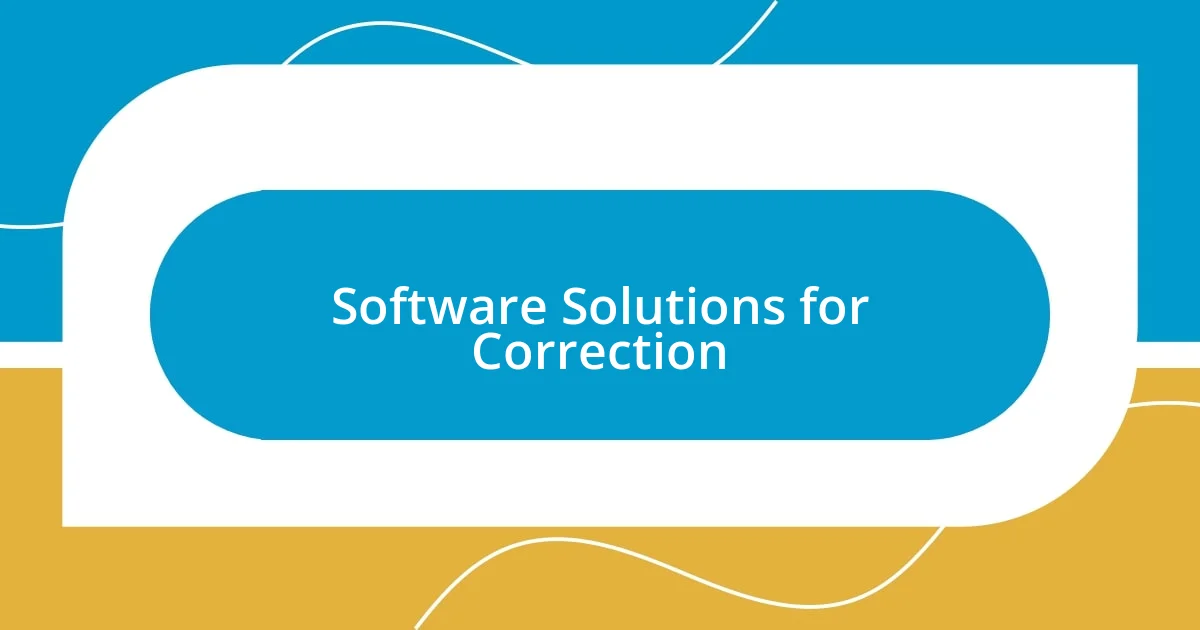
Software Solutions for Correction
When it comes to software solutions, I’ve found that programs like Adobe Lightroom and Photoshop are my go-to tools for correcting lens distortion. The way these applications offer built-in profiles for specific lenses is truly a lifesaver. I remember a landscape shot I had taken, which had significant barrel distortion due to my wide-angle lens. With just a few clicks on the distortion slider, I watched that curved horizon snap back to its intended straightness, and it felt like magic.
Another software that has impressed me is Capture One, particularly for its raw processing capabilities. After importing my images, I noticed how well it handled distortion corrections while preserving fine details in the image. I often find myself wondering, how can I achieve the cleanest results possible? My experience tells me that using Capture One not only fixes distortion but enhances the overall quality of my photos, making them even more striking.
Then there’s the world of mobile editing apps, like Snapseed, which I rely on when I’m on the go. The beauty of these apps is their intuitiveness; I love how easy it is to twist and tweak my images right from my phone. I once quickly edited a street photo during lunch, and the difference in clarity was astounding! It truly highlights how accessible technology has become—enabling me to tackle distortion anytime, anywhere. Isn’t it incredible how we’ve moved from traditional darkroom techniques to having powerful editing tools at our fingertips?
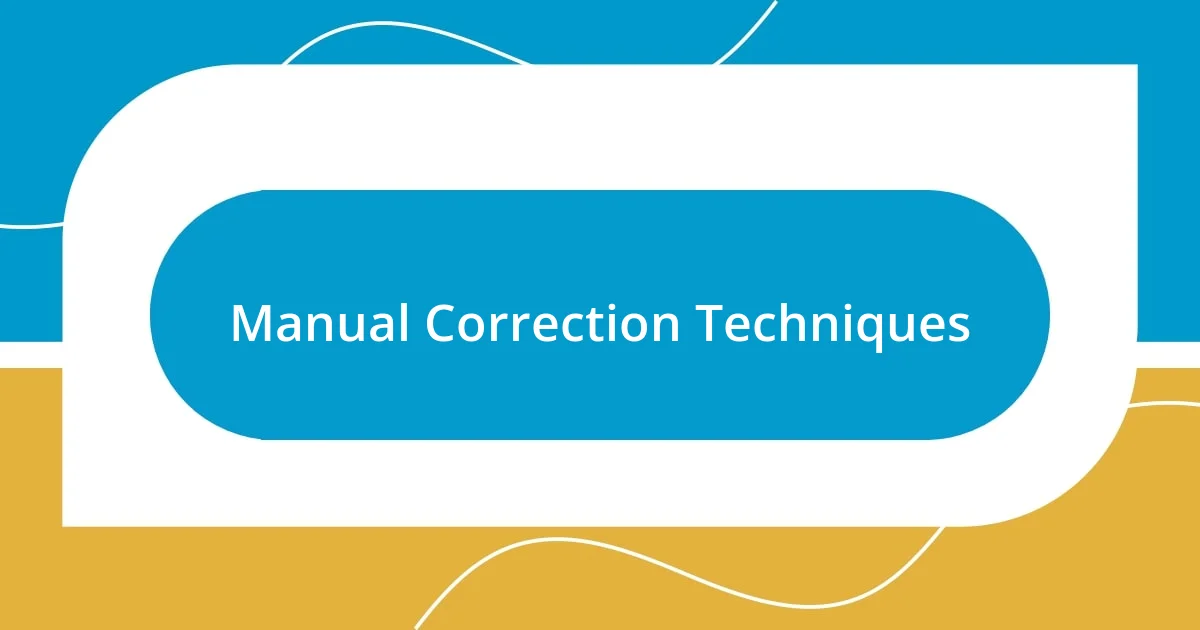
Manual Correction Techniques
Understanding manual correction techniques for lens distortion can be incredibly empowering. I remember sitting down with a few of my favorite images, determined to tackle the imperfections by hand. Using the cropping tool became my first step; trimming edges often helps to remove some noticeable distortion, especially when the edges are most affected. It was a simple yet satisfying process, allowing me to regain control over my images.
Another technique I leaned on was adjusting perspective. I often find that when photographing architecture, using the transform tools can help straighten those lines that seem to bend under pressure. On one occasion, I was photographing a stunning cathedral, and, after a bit of manipulation, it felt like the building was standing tall and proud again. I’ve learned to trust my instincts here—if my gut says something feels off, it usually is!
Don’t overlook the power of blending in multiple exposures. I’ve played around with this technique after realizing that different sections of an image can be corrected independently. For example, I paired a shot with noticeable barrel distortion with a cleaner version captured just a moment later. Layering those images together taught me that sometimes, beauty lies in the nuances of correction. Have you ever tried this approach? It’s a bit of trial and error, but the results can be breathtaking!
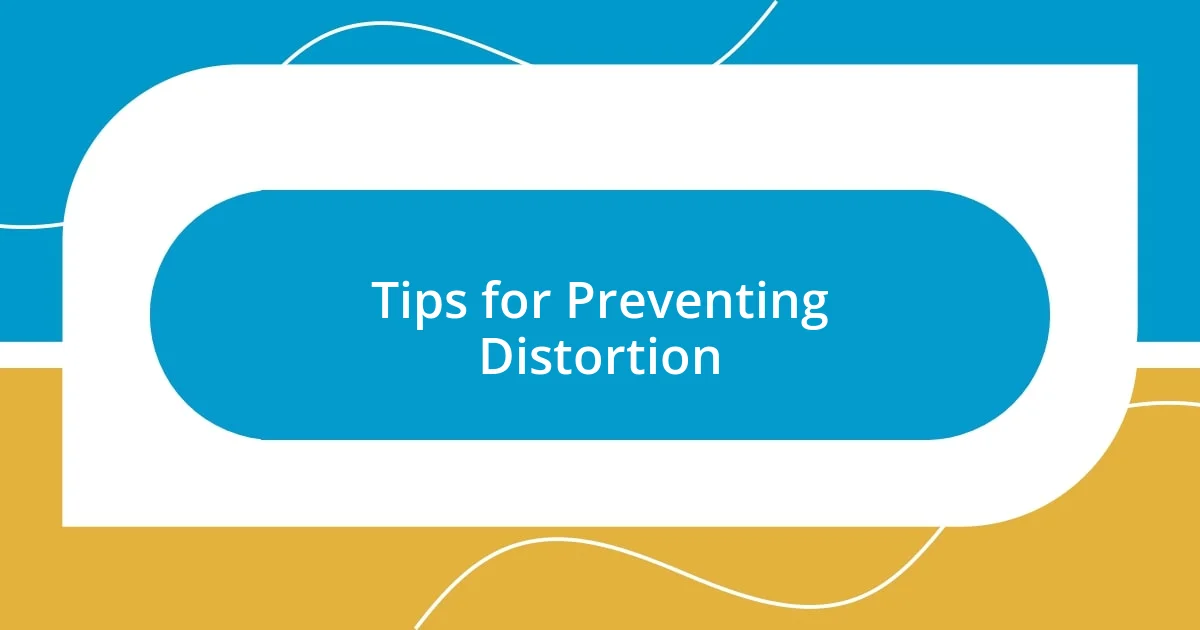
Tips for Preventing Distortion
When it comes to preventing lens distortion right from the start, one of the best practices I’ve adopted is mindful lens selection. I’ve spent countless hours researching which lenses are best suited for my style of photography, and trust me, it pays off. For instance, using prime lenses generally results in less distortion compared to zoom lenses. Have you ever noticed how certain lenses can skew reality? Choosing wisely can make a world of difference in the quality of your images.
In addition to selecting the right lens, proper camera positioning is crucial. I can’t tell you how many times I’ve had to redo a shot because I wasn’t standing at the right angle. For example, when I’m photographing buildings, if I tilt the camera down or up too much, the lines can warp horrifically. Now, I always try to keep my camera level and make adjustments to my own position instead. It’s amazing how corrective techniques can sometimes start long before I even press the shutter.
Lastly, I’ve learned the significance of shooting at optimal aperture settings. I remember the first time I experimented with different apertures; I was astounded to see how much clearer my images were when I shot at f/8 instead of wide open at f/2.8. Not only did this prevent light-falloff issues near the edges, but it also enhanced sharpness across the board. Why not give it a try? It’s such a simple change but can drastically improve the integrity of your shots, reducing the need for extensive post-editing later.
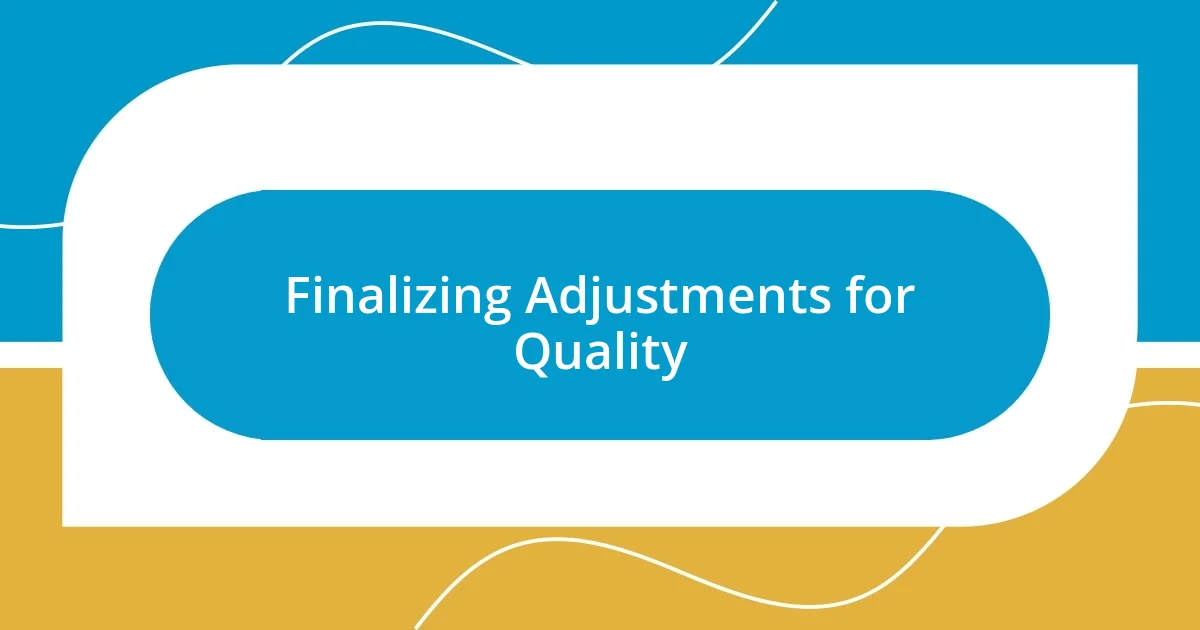
Finalizing Adjustments for Quality
After all the manual adjustments, I always take a moment to review the overall quality. I find it helpful to zoom in on various sections of the photo to catch any lingering distortions that may have slipped past me. One time, I missed a subtle curve at the bottom of an image, which really bothered me later. Trust me, a little extra scrutiny can save you from disappointment.
Next, I focus on color grading and contrast to breathe life back into my images. I remember a particularly vibrant sunset shot that lost some of its punch after correction. By adjusting the color balance and playing with contrast, I transformed it back to the stunning scene I had originally captured. Do you ever feel like your edits dull your images? I know I do sometimes, but tweaking those final settings can bring back that spark.
Finally, I can’t stress enough how important it is to get second opinions on my work. I often share corrected images with fellow photographers in my circle. Their fresh perspectives can reveal flaws I might have overlooked, and it’s a great collaborative way to ensure we’re all presenting our best selves. Have you considered sharing your work with others? It can be incredibly rewarding, and I always come away with new insights and ideas for future projects.












